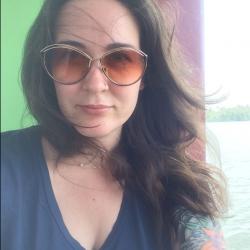So, What Do You Do? Part 1
February 14, 2019
“So, What Do You Do?” is a new MM series featuring extraordinary women in the kinds of jobs that make you sit up and say, “What’s that like?” Every week, another original entrepreneur, executive, artist, or scientist will own the answer by sharing what she does, how she does it, and why she does what she does. Up this week, Dr. Jillian Bellovary, astrophysicist, on black holes, bullet journals, and creating diversity in her field.
When Dr. Jillian Bellovary explains her job to regular people, they’re usually impressed. Do they understand it? “No,” she says. “But they want to.” As an astrophysicist, Bellovary studies massive black holes and gravitational waves at New York’s American Museum of Natural History. She also teaches the ways of the cosmos to a diverse student body as an assistant professor of physics at Queensborough Community College in Queens, New York. “I want to validate my students’ backgrounds,” she says, by educating them about multicultural achievements in astronomy. As a member of the Committee for the Status of Minorities in Astronomy, Bellovary aims to bring underrepresented minorities into the field of astrophysics.
Here’s just some of what she does in a day:
Goes to work at one of the most fascinating science museums in the world.
“At the Museum of Natural History, sometimes I spend so much time discussing science issues, student issues, departmental issues that I forget the science I was trying to do in the first place. We also have regular meetups where we drink coffee and discuss new research papers. I voted for one today about dark matter in dwarf galaxies.”
Entertains the big questions.
“I was never interested in how stars work—they’re too small. I like big-picture things, questions like, how did the universe form? How did we get here? What is our place as meager humans in the mighty cosmos? Astronomy gives me perspective on this beautiful and enormous thing we are part of, and how great it is that we are evolved enough to learn about it. And how totally insignificant we are.”
Writes ground-breaking grants.
“I recently wrote a big grant for the National Science Foundation with a budget of nearly a million dollars. It’s almost certainly not going to be funded but I’m still really proud of it because I put together a 5- to 10-year science plan with goals, objectives, and ways to solve everything. It took me six months to write! Because I did that, I feel like I’ve finally made it as a scientist.”
Keeps a handle on life.
“I use a bullet journal that I divide into categories—science, teaching, life, self-care, and whatever else is going on. I use different-colored pens for each part, because it looks pretty. It really helps me keep track of everything.”
Consorts with writers in bars.
“I love to talk about black holes to the public. I recently went to a cool little bar and spoke to science journalists, who were drinking cocktails and laughing and asking questions. That’s the glamorous part of the job. The least glamorous is grading papers.”
Teaches college kids active learning.
“I use a flipped classroom, which means students watch my lectures online before class. Then in class, we do a hands-on activity that reinforces my lecture, so they’re actually using their brains instead of just watching me go ‘Blah, blah, blah, blah, blah.’ ”
Experiences vicarious thrills.
“When students say to me, ‘Hey, thinking about this stuff has changed the way that I see the world.’ I’m just like, whoa. I affected somebody’s life, that’s amazing! If I’m mentoring a research student, it’s when they have their a-ha! moment.”









